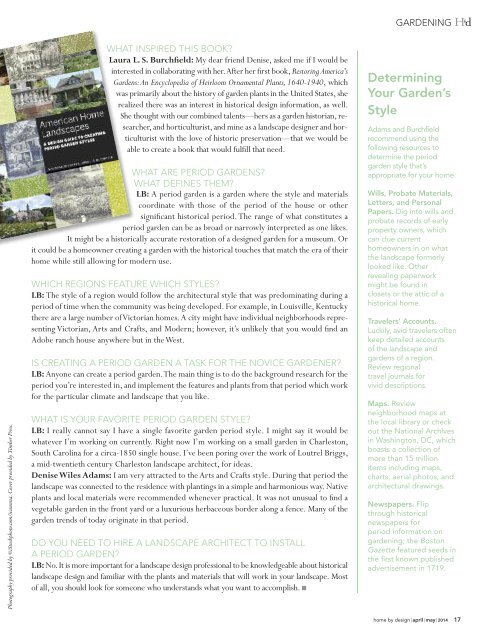7HQtGH
7HQtGH
7HQtGH
Create successful ePaper yourself
Turn your PDF publications into a flip-book with our unique Google optimized e-Paper software.
GARDENING<br />
Photography provided by ©iStockphoto.com/ ivannna. Cover provided by Timber Press.<br />
WHAT INSPIRED THIS BOOK<br />
Laura L. S. Burchfield: My dear friend Denise, asked me if I would be<br />
interested in collaborating with her. After her first book, Restoring America's<br />
Gardens: An Encyclopedia of Heirloom Ornamental Plants, 1640-1940, which<br />
was primarily about the history of garden plants in the United States, she<br />
realized there was an interest in historical design information, as well.<br />
She thought with our combined talents—hers as a garden historian, researcher,<br />
and horticulturist, and mine as a landscape designer and horticulturist<br />
with the love of historic preservation—that we would be<br />
able to create a book that would fulfill that need.<br />
WHAT ARE PERIOD GARDENS<br />
WHAT DEFINES THEM<br />
LB: A period garden is a garden where the style and materials<br />
coordinate with those of the period of the house or other<br />
significant historical period. The range of what constitutes a<br />
period garden can be as broad or narrowly interpreted as one likes.<br />
It might be a historically accurate restoration of a designed garden for a museum. Or<br />
it could be a homeowner creating a garden with the historical touches that match the era of their<br />
home while still allowing for modern use.<br />
WHICH REGIONS FEATURE WHICH STYLES<br />
LB: The style of a region would follow the architectural style that was predominating during a<br />
period of time when the community was being developed. For example, in Louisville, Kentucky<br />
there are a large number of Victorian homes. A city might have individual neighborhoods representing<br />
Victorian, Arts and Crafts, and Modern; however, it’s unlikely that you would find an<br />
Adobe ranch house anywhere but in the West.<br />
IS CREATING A PERIOD GARDEN A TASK FOR THE NOVICE GARDENER<br />
LB: Anyone can create a period garden. The main thing is to do the background research for the<br />
period you’re interested in, and implement the features and plants from that period which work<br />
for the particular climate and landscape that you like.<br />
WHAT IS YOUR FAVORITE PERIOD GARDEN STYLE<br />
LB: I really cannot say I have a single favorite garden period style. I might say it would be<br />
whatever I’m working on currently. Right now I’m working on a small garden in Charleston,<br />
South Carolina for a circa-1850 single house. I’ve been poring over the work of Loutrel Briggs,<br />
a mid-twentieth century Charleston landscape architect, for ideas.<br />
Denise Wiles Adams: I am very attracted to the Arts and Crafts style. During that period the<br />
landscape was connected to the residence with plantings in a simple and harmonious way. Native<br />
plants and local materials were recommended whenever practical. It was not unusual to find a<br />
vegetable garden in the front yard or a luxurious herbaceous border along a fence. Many of the<br />
garden trends of today originate in that period.<br />
DO YOU NEED TO HIRE A LANDSCAPE ARCHITECT TO INSTALL<br />
A PERIOD GARDEN<br />
LB: No. It is more important for a landscape design professional to be knowledgeable about historical<br />
landscape design and familiar with the plants and materials that will work in your landscape. Most<br />
of all, you should look for someone who understands what you want to accomplish.<br />
Determining<br />
Your Garden’s<br />
Style<br />
Adams and Burchfield<br />
recommend using the<br />
following resources to<br />
determine the period<br />
garden style that’s<br />
appropriate for your home.<br />
Wills, Probate Materials,<br />
Letters, and Personal<br />
Papers. Dig into wills and<br />
probate records of early<br />
property owners, which<br />
can clue current<br />
homeowners in on what<br />
the landscape formerly<br />
looked like. Other<br />
revealing paperwork<br />
might be found in<br />
closets or the attic of a<br />
historical home.<br />
Travelers’ Accounts.<br />
Luckily, avid travelers often<br />
keep detailed accounts<br />
of the landscape and<br />
gardens of a region.<br />
Review regional<br />
travel journals for<br />
vivid descriptions.<br />
Maps. Review<br />
neighborhood maps at<br />
the local library or check<br />
out the National Archives<br />
in Washington, DC, which<br />
boasts a collection of<br />
more than 15 million<br />
items including maps,<br />
charts, aerial photos, and<br />
architectural drawings.<br />
Newspapers. Flip<br />
through historical<br />
newspapers for<br />
period information on<br />
gardening; the Boston<br />
Gazette featured seeds in<br />
the first known published<br />
advertisement in 1719.<br />
home by design|april|may|2014 17


